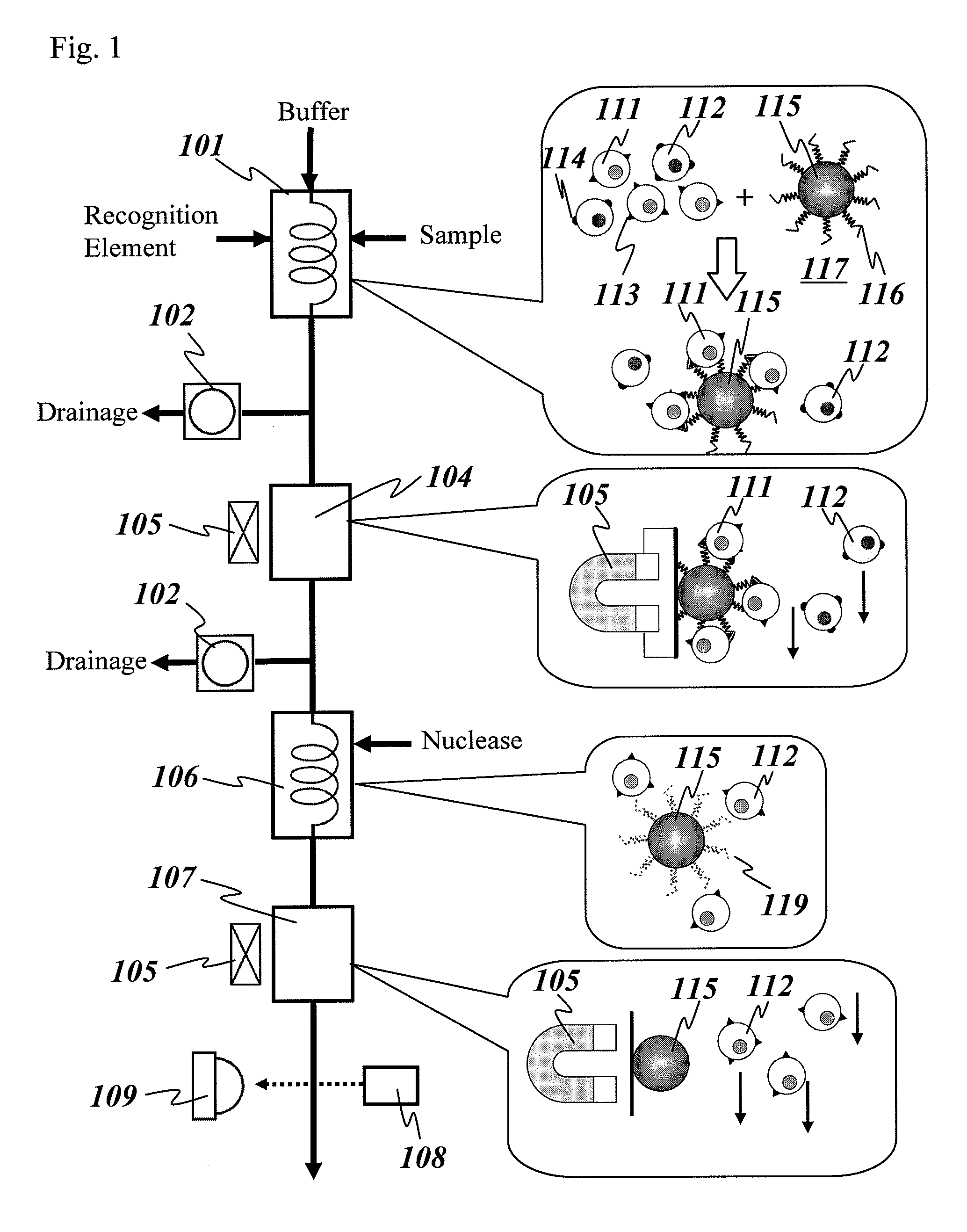Cell isolation method, cell testing method and reagent kit therefor
a cell isolation and cell technology, applied in the field of cell isolation methods, can solve the problems of large device size, high price of flow cytometers and cell sorters, and large sample quantity, and achieve the effects of easy cell isolation, easy removal, and increased stability
- Summary
- Abstract
- Description
- Claims
- Application Information
AI Technical Summary
Benefits of technology
Problems solved by technology
Method used
Image
Examples
example 1
[0095]A device example in which an RNA aptamer is used as a substance for the recognition of cell surface antigen CD4 and in which paramagnetic particles with a particle diameter of 3 μm are used in the isolation and recovery of cells bound to the RNA aptamer is explained hereinbelow. In other words, recognition elements composed of the above-described RNA aptamer and paramagnetic particles are used, and a magnetic field is utilized, to isolate and recover cell surface antigen CD4 presenting cells.
[0096]FIG. 1 is a diagram explaining the isolation system and flow thereof. 101 is a first mixing tank in which the sample cell groups which comprise the sample, a recognition element, and buffers for cleaning and dilution are introduced and mixed. In a first mixing tank 101, as indicated by the magnified image on the right side, a target cell 111 cell group which has a CD4 cell surface antigen 113 and is indicated by a ▴, a cell 112 cell group which has a cell surface antigen 114 other th...
example 2
[0108]FIGS. 2(A) and 2(B) are figures that show a device example and a method in which cell surface antigen CD4 presenting cells are isolated and recovered with a magnetic field using recognition elements comprising paramagnetic particles modified with RNA aptamer that recognizes cell surface antigen CD4.
[0109]FIG. 2(A) is a conceptual diagram showing a screening device. Sample tube 202, dispensing mechanism 201, and magnetic field generation mechanism 203 is the smallest constituent unit. In addition, a tube retaining recognition element solution 204 (3 μm paramagnetic particles 208 modified by an RNA aptamer that recognizes cell surface antigen CD4 is intermixed), and a tube 205 that retains a nuclease solution are prepared. The movement of dispensing mechanism 201 is controlled in the x direction, y direction (perpendicular to sheet surface), and z direction. In addition, magnetic field generation mechanism 203 is movable, and the strength of the magnetic field within sample tube...
example 3
[0112]A testing kit can be realized through the application of the present invention. Hereinbelow, a case is explained in which cell surface antigen CD44, which binds to an RNA aptamer, is the recognition substance and paramagnetic particles (particle diameter 1 μm) are used as the recognition element carrier. Explained here are separation detection of cells that express CD44 as a cell surface antigen and said cells are deprived, cancer-derived cells in fecal matter, and a testing kit therefor.
[0113]0.1 g of fecal matter, which is the test specimen, is suspended in a buffer of 1 mL of 10 mM PBS (pH 7.5), 0.15 M NaCL, 1% BSA and used as a sample. RNA aptamer-modified paramagnetic particles (recognition element) are added to the sample solution, which is gently stirred for 30 minutes. The suspension is fed into a tube with an internal diameter of 2 mm, and magnetic particles moving inside the tube, which has a neodymium magnet array arranged at 1 cm intervals, are trapped. The collect...
PUM
| Property | Measurement | Unit |
|---|---|---|
| diameter | aaaaa | aaaaa |
| diameter | aaaaa | aaaaa |
| particle diameter | aaaaa | aaaaa |
Abstract
Description
Claims
Application Information
 Login to View More
Login to View More - R&D
- Intellectual Property
- Life Sciences
- Materials
- Tech Scout
- Unparalleled Data Quality
- Higher Quality Content
- 60% Fewer Hallucinations
Browse by: Latest US Patents, China's latest patents, Technical Efficacy Thesaurus, Application Domain, Technology Topic, Popular Technical Reports.
© 2025 PatSnap. All rights reserved.Legal|Privacy policy|Modern Slavery Act Transparency Statement|Sitemap|About US| Contact US: help@patsnap.com


